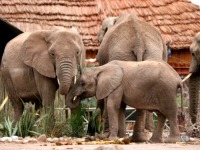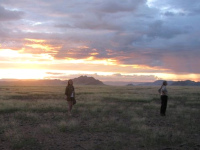Voluntourism: Proving gap years aren't just for students
Growing numbers of travellers want to do more than just look at a destination, they want to get involved. As students start to sort out their gap years, Ruth Styles discovered that in Namibia, conservation work and a great trip go hand-in-hand, and not just for those about to start university.
It’s dawn in Sossuvlei. The sun creeps up over the hills behind us, lending the vast ochre dunes of the Namib Desert a rosy glow. 1200 miles long and 70 miles wide, everything about the desert, from the 240-foot dunes to the endless horizons, is vast. Namibia is home to both the world’s oldest desert and to some seriously endangered wildlife.
Currently, it supports the largest population of black rhino in Africa along with 70,000 springbok antelopes, gemsbok and kudu. It also has large numbers of ostrich, lions and the rare desert-adapted elephant. But 20 years ago, it was a different story. Poaching in the 1980s decimated Namibia’s elephant and black rhino populations, with the rhinos hunted almost to extinction and saved only by the efforts of local people, concerned volunteers and NGOs such as the WWF.
 A rare sighting of the black rhino
A rare sighting of the black rhinoiStockphoto / Thinkstock
The solution they came up with was the conservancy: a type of reserve that combines eco-tourism with providing a livelihood for locals. Since their introduction, the black rhino population has tripled. And it doesn’t end there. According to the Predator Conservation Trust, an NGO dedicated to protecting the world's big cats, the lion population of Namibia saw an annual increase of 30% during the first half of the noughties. And it’s this kind of result that responsible voluntourism and green travel can help bring about, and why I wanted to do more than just read about conservation efforts on my trip.
The first stop on my green tour of Namibia was Damaraland. Located in the heart of the Huab River Valley, 90 kilometres from the Skeleton Coast and possessing spectacular views of the Brandeburg Mountains, Damaraland is home to a plethora of species, including the critically endangered desert-adapted elephant.
 Volunteers can help with research on desert elephants
Volunteers can help with research on desert elephantsiStockphoto / Thinkstock
Chatting with the local staff at the camp, it soon became clear that they were committed conservationists to a man, with Johan – our guide for the following morning’s elephant-tracking trip – proving particularly passionate. And it isn’t just the animals that the camp’s work helps to preserve. That night, during dinner, we were treated to a taste of the local culture in the form of traditional songs performed by camp staff, still in their safari gear.
The next morning we headed out with Johan to find the elephants and were given a lesson in tracking at the same time. Spotting a clump of trampled down euphorbia – a succulent bush with poisonous sap – Johan was full of anecdotes about how the pachyderms use it to rid themselves of irritating mites and ticks, and how local people once used it to make poisoned arrows for hunting. With the sun breaking through the jagged gaps in the hills, we headed off across a dried up river-bed into a valley where, according to Johan, elephants are sometimes seen. Suddenly he stopped and sprang from the jeep to examine an unprepossessing looking piece of ground. Gathering round to take a closer look, a muddy footprint could be seen in a patch of flattened grass. But it wasn’t an elephant print. It came from the rare black rhino.
Black rhino poaching during the 1980s led to the almost total eradication of the species and it’s only recently that numbers have started to increase. Seeing them in the wild is almost impossible as the canny survivors fled to remote mountainsides and inaccessible valleys. In Damaraland, which, like the rest of Namibia, had a serious poaching problem, black rhinos are still thin on the ground so seeing a print like this wasn’t just unexpected – it was also testimony to the hugely successful rhino reintegration project operating in the area. Damaraland is part of a WWF programme aimed at returning black rhinos to their original habitats with the help of volunteers, villagers and conservation experts. Helicopter-based snipers dart gun the animals to sedate them before they’re slung in a supersized hammock and choppered away to their new homes. The rhino whose spoor we saw was one of the returnees, and Johan was jubilant.
 Volunteers enjoy the sunset after a hard day's work
Volunteers enjoy the sunset after a hard day's workRuth Styles
An environment club to teach children about the importance of conserving their panoramic surroundings had been set up; while Wilderness Safaris – the company that runs Damaraland Camp – has an initiative called Children in the Wilderness, which brings disadvantaged Namibian children to the camp to learn more about conservation. Damaraland isn’t the only Wilderness Safaris camp where your money is transformed into conservation projects either. Further south, at the Little Kulala and Kulala Wilderness camps in the Namib-Nakluft National Park, I found more locals showing a real passion for protecting Namibia’s natural heritage. Never, in the UK, have I seen someone make a detour just to pick up a bit of rubbish by the road, but our guides, Richard and Elaine, did it repeatedly. During my time in Namibia, I met plenty of fellow travellers also involved in conservation projects. In Damaraland, I shared supper with a pair of German researchers who were helping to track and tag the local kudu population.
At another Wilderness property – the Desert Rhino camp – you can get involved in black rhino monitoring, with proceeds from your tracking adventure going direct to the Save the Rhino Trust. But if conservation isn’t what you’re looking for, there are plenty of African destinations offering the chance to get involved in projects that directly benefit local people. On another trip to Uganda, I helped out at Kampala orphanage, the Nsambya Babies Home, along with several other volunteers before heading south for a visit to the Queen Elizabeth National Park. It wasn’t easy to leave the children I had bonded with behind, but I felt that I’d really made a difference – if only for a few weeks.
Unfortunately, voluntourism isn’t without its controversies. While a trip like mine, which involved helping a local guide gather data about wildlife populations and putting extra cash into the local economy are a positive boon for conservationists and villagers alike, others aren’t quite so helpful. Building projects have provoked criticism from people who argue that building work should go to local builders, not untried volunteers who don’t know how to ensure that new builds are properly constructed. Teaching is another sector in which the helpfulness of volunteers has been questioned. Does putting an 18 year-old non-teacher in charge of a month of classes really improve the Ugandan education system? The answer is probably not. For would-be voluntourists, this has created confusion – what can you do that genuinely makes a difference?
 Ruth Styles takes a break during her Namibia trip
Ruth Styles takes a break during her Namibia tripRuth Styles and Dana Allen
Monitoring projects are always a good bet as your presence isn’t affecting local jobs and takes the pressure off over-stretched guides. Another good option is to muck in at a big cat rehabilitation centre such as the Cango Wildlife Ranch in South Africa where you can spend time helping to bottle feed orphaned cubs or playing with a Bengal tiger. Again, it takes the pressure off staff and your money helps to keep the centre going. Trips that involve clean-up operations are also worth looking at, with Gap Year For Grown Ups operating an excellent one taking you to Cairo, where you’ll be helping locals tidy up their stretch of Nile riverbank. The key to a successful voluntouring trip is, according to Responsible Tourism, that it ‘generates greater economic benefits for local people and enhances the wellbeing of host communities; improves working conditions and access to the industry’. If the trip you’re looking at doesn’t do that, it might be time to check out something else.
Back in Damaraland, a place where rivers appear in the morning and are gone by midday, the flora and fauna living in the rocky landscape are uniquely adapted to desert life and are all the more precious for that. It’s satisfying to think that simply by staying in a local lodge and helping out a local guide for a couple of days, I’ve contributed to making sure that this amazing landscape is preserved for future generations. It is projects like this that have helped the black rhino and the desert elephant to not only survive but flourish in modern Namibia, and have helped to boost living standards for locals along the way. Surely that beats a beach break.
Voluntourism is no longer just for students on their gap year. Travel company Gap Year for Grown Ups estimates that more than 100,000 of us each year take the opportunity to work in Guatemalan orphanages, help stop the bush meat trade in Kenya and contribute to house building projects in India while on holiday. The growing number of ‘voluntourists’ is a reflection, in part, of the current vogue for a greener, more socially aware travel experience, as highlighted by Green Tourism week.
Need to know
A seven-night trip, with one night in Windhoek, two nights in the Namib-Naukluft Park at Kulala Desert Lodge and two nights at Damaraland Camp costs from £3,704 per person sharing. This includes scheduled flights with Air Namibia from Frankfurt to Windhoek, with British Airways feeder flights from London Heathrow to Frankfurt, light aircraft transfers between camps in Namibia, all accommodation, meals and activities.
Air Namibia fly to Windhoek from £815. To book call 0870 774 0965 or visit www.airnamibia.com.na
Do you have any Feedback about this page?
© 2025 Columbus Travel Media Ltd. All rights reserved. No part of this site may be reproduced without our written permission, click here for information on Columbus Content Solutions.









 You know where
You know where